16.3: Doppler Effect and Sonic Booms
- Page ID
- 14538
\( \newcommand{\vecs}[1]{\overset { \scriptstyle \rightharpoonup} {\mathbf{#1}} } \)
\( \newcommand{\vecd}[1]{\overset{-\!-\!\rightharpoonup}{\vphantom{a}\smash {#1}}} \)
\( \newcommand{\dsum}{\displaystyle\sum\limits} \)
\( \newcommand{\dint}{\displaystyle\int\limits} \)
\( \newcommand{\dlim}{\displaystyle\lim\limits} \)
\( \newcommand{\id}{\mathrm{id}}\) \( \newcommand{\Span}{\mathrm{span}}\)
( \newcommand{\kernel}{\mathrm{null}\,}\) \( \newcommand{\range}{\mathrm{range}\,}\)
\( \newcommand{\RealPart}{\mathrm{Re}}\) \( \newcommand{\ImaginaryPart}{\mathrm{Im}}\)
\( \newcommand{\Argument}{\mathrm{Arg}}\) \( \newcommand{\norm}[1]{\| #1 \|}\)
\( \newcommand{\inner}[2]{\langle #1, #2 \rangle}\)
\( \newcommand{\Span}{\mathrm{span}}\)
\( \newcommand{\id}{\mathrm{id}}\)
\( \newcommand{\Span}{\mathrm{span}}\)
\( \newcommand{\kernel}{\mathrm{null}\,}\)
\( \newcommand{\range}{\mathrm{range}\,}\)
\( \newcommand{\RealPart}{\mathrm{Re}}\)
\( \newcommand{\ImaginaryPart}{\mathrm{Im}}\)
\( \newcommand{\Argument}{\mathrm{Arg}}\)
\( \newcommand{\norm}[1]{\| #1 \|}\)
\( \newcommand{\inner}[2]{\langle #1, #2 \rangle}\)
\( \newcommand{\Span}{\mathrm{span}}\) \( \newcommand{\AA}{\unicode[.8,0]{x212B}}\)
\( \newcommand{\vectorA}[1]{\vec{#1}} % arrow\)
\( \newcommand{\vectorAt}[1]{\vec{\text{#1}}} % arrow\)
\( \newcommand{\vectorB}[1]{\overset { \scriptstyle \rightharpoonup} {\mathbf{#1}} } \)
\( \newcommand{\vectorC}[1]{\textbf{#1}} \)
\( \newcommand{\vectorD}[1]{\overrightarrow{#1}} \)
\( \newcommand{\vectorDt}[1]{\overrightarrow{\text{#1}}} \)
\( \newcommand{\vectE}[1]{\overset{-\!-\!\rightharpoonup}{\vphantom{a}\smash{\mathbf {#1}}}} \)
\( \newcommand{\vecs}[1]{\overset { \scriptstyle \rightharpoonup} {\mathbf{#1}} } \)
\( \newcommand{\vecd}[1]{\overset{-\!-\!\rightharpoonup}{\vphantom{a}\smash {#1}}} \)
\(\newcommand{\avec}{\mathbf a}\) \(\newcommand{\bvec}{\mathbf b}\) \(\newcommand{\cvec}{\mathbf c}\) \(\newcommand{\dvec}{\mathbf d}\) \(\newcommand{\dtil}{\widetilde{\mathbf d}}\) \(\newcommand{\evec}{\mathbf e}\) \(\newcommand{\fvec}{\mathbf f}\) \(\newcommand{\nvec}{\mathbf n}\) \(\newcommand{\pvec}{\mathbf p}\) \(\newcommand{\qvec}{\mathbf q}\) \(\newcommand{\svec}{\mathbf s}\) \(\newcommand{\tvec}{\mathbf t}\) \(\newcommand{\uvec}{\mathbf u}\) \(\newcommand{\vvec}{\mathbf v}\) \(\newcommand{\wvec}{\mathbf w}\) \(\newcommand{\xvec}{\mathbf x}\) \(\newcommand{\yvec}{\mathbf y}\) \(\newcommand{\zvec}{\mathbf z}\) \(\newcommand{\rvec}{\mathbf r}\) \(\newcommand{\mvec}{\mathbf m}\) \(\newcommand{\zerovec}{\mathbf 0}\) \(\newcommand{\onevec}{\mathbf 1}\) \(\newcommand{\real}{\mathbb R}\) \(\newcommand{\twovec}[2]{\left[\begin{array}{r}#1 \\ #2 \end{array}\right]}\) \(\newcommand{\ctwovec}[2]{\left[\begin{array}{c}#1 \\ #2 \end{array}\right]}\) \(\newcommand{\threevec}[3]{\left[\begin{array}{r}#1 \\ #2 \\ #3 \end{array}\right]}\) \(\newcommand{\cthreevec}[3]{\left[\begin{array}{c}#1 \\ #2 \\ #3 \end{array}\right]}\) \(\newcommand{\fourvec}[4]{\left[\begin{array}{r}#1 \\ #2 \\ #3 \\ #4 \end{array}\right]}\) \(\newcommand{\cfourvec}[4]{\left[\begin{array}{c}#1 \\ #2 \\ #3 \\ #4 \end{array}\right]}\) \(\newcommand{\fivevec}[5]{\left[\begin{array}{r}#1 \\ #2 \\ #3 \\ #4 \\ #5 \\ \end{array}\right]}\) \(\newcommand{\cfivevec}[5]{\left[\begin{array}{c}#1 \\ #2 \\ #3 \\ #4 \\ #5 \\ \end{array}\right]}\) \(\newcommand{\mattwo}[4]{\left[\begin{array}{rr}#1 \amp #2 \\ #3 \amp #4 \\ \end{array}\right]}\) \(\newcommand{\laspan}[1]{\text{Span}\{#1\}}\) \(\newcommand{\bcal}{\cal B}\) \(\newcommand{\ccal}{\cal C}\) \(\newcommand{\scal}{\cal S}\) \(\newcommand{\wcal}{\cal W}\) \(\newcommand{\ecal}{\cal E}\) \(\newcommand{\coords}[2]{\left\{#1\right\}_{#2}}\) \(\newcommand{\gray}[1]{\color{gray}{#1}}\) \(\newcommand{\lgray}[1]{\color{lightgray}{#1}}\) \(\newcommand{\rank}{\operatorname{rank}}\) \(\newcommand{\row}{\text{Row}}\) \(\newcommand{\col}{\text{Col}}\) \(\renewcommand{\row}{\text{Row}}\) \(\newcommand{\nul}{\text{Nul}}\) \(\newcommand{\var}{\text{Var}}\) \(\newcommand{\corr}{\text{corr}}\) \(\newcommand{\len}[1]{\left|#1\right|}\) \(\newcommand{\bbar}{\overline{\bvec}}\) \(\newcommand{\bhat}{\widehat{\bvec}}\) \(\newcommand{\bperp}{\bvec^\perp}\) \(\newcommand{\xhat}{\widehat{\xvec}}\) \(\newcommand{\vhat}{\widehat{\vvec}}\) \(\newcommand{\uhat}{\widehat{\uvec}}\) \(\newcommand{\what}{\widehat{\wvec}}\) \(\newcommand{\Sighat}{\widehat{\Sigma}}\) \(\newcommand{\lt}{<}\) \(\newcommand{\gt}{>}\) \(\newcommand{\amp}{&}\) \(\definecolor{fillinmathshade}{gray}{0.9}\)learning objectives
- Identify parameters required to calculate the frequency perceived by the observer moving towards the sound source
In this atom, we are going to cover the Doppler effect, but specifically when the observer is the one in motion.
Sound and the Doppler Effect: This video introduces sound waves. The first video describes the basics of sound while the second video looks at the Doppler Effect.
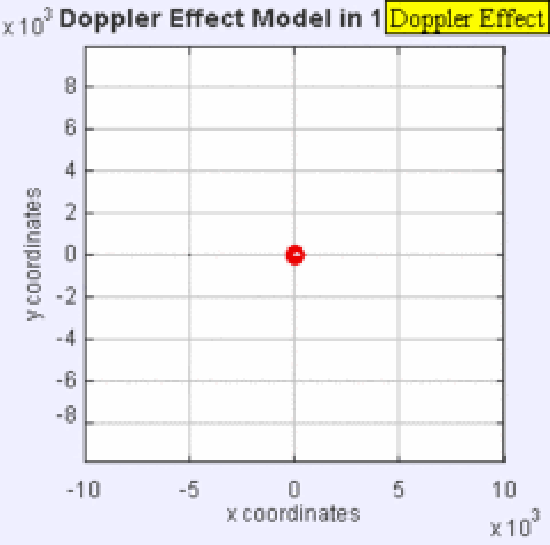
The Doppler Effect: The same sound source is radiating sound waves at a constant frequency in the same medium. However, now the sound source is moving to the right with a speed υs = 0.7 c (Mach 0.7). The wave-fronts are produced with the same frequency as before. However, since the source is moving, the centre of each new wavefront is now slightly displaced to the right. As a result, the wave-fronts begin to bunch up on the right side (in front of) and spread further apart on the left side (behind) of the source.
When the observer moves toward an sound source, each successive wave is encountered sooner than the previous wave. Thus, it will take just a little less time for the observer to hear the next one. Since the time between waves is reduced, the frequency is increased. Similarly if the observer is moving away from the sound source, the frequency, and therefor pitch, is decreased. While the frequency will change whether the observer or sound source is moving, it is easier to show with the sound source as the one moving. This figure demonstrated the sound source moving:
Unless the observer is moving directly towards the sound source, this angle needs to be taken into account when calculating the newly perceived frequency. Before we can start this calculation, we must know:
- The original sound wave frequency, f0
- The velocity of the observer, vr
- The speed of sound in the air, or medium, c
- The angle of the line of sight from the observer to the sound source, θθ
Although the sound waves are being emitted from the sound source at a uniform frequency, the observer is perceiving them differently. The equation for the perceived wave frequency is as follows: \(\mathrm{f=\frac{c±v_{r,new}}{c} \times f_0}\)And the equation for vr, is: \(\mathrm{v_{r,new}=v_r \cos θ}\) If the observer is moving towards the sound source, you are going to use a plus sign in front of the observers velocity. If the observer is moving away from sound source, you are going to use a negative sign in front of the observers velocity.
Moving Source
The Doppler effect is the apparent change in frequency of a wave when the observer and the source of the wave move relative to each other.
learning objectives
- Identify parameters required to calculate the perceived frequency of the sound source moving towards an observer
The Doppler Effect —When the Sound Source is in Motion
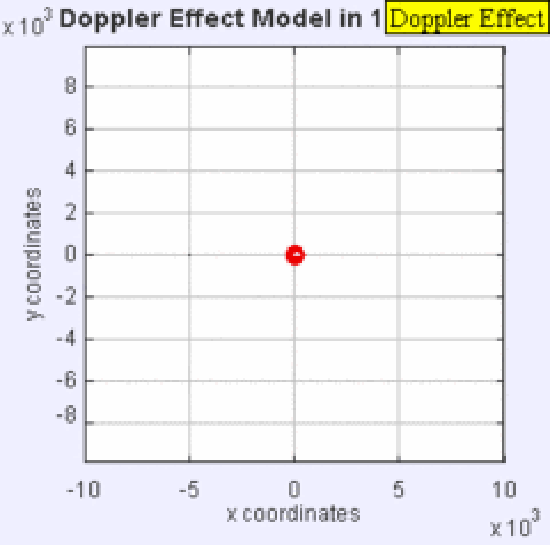
The Doppler Effect: The same sound source is radiating sound waves at a constant frequency in the same medium. However, now the sound source is moving to the right with a speed υs = 0.7 c ( Mach 0.7). The wave-fronts are produced with the same frequency as before. However, since the source is moving, the centre of each new wavefront is now slightly displaced to the right. As a result, the wave-fronts begin to bunch up on the right side (in front of) and spread further apart on the left side (behind) of the source.
When the sound source moves toward an observer, each successive wave is emitted closer to the observer than the previous wave and takes just a little less time to reach the observer than the previous one. Since the time between waves is reduced, the frequency is increased. Similarly, if the sound source is moving away from the observer, the frequency (and therefore pitch) is decreased. While the frequency will change whether the observer or sound source is moving, the effect is more easily demonstrated by the sound source. This Doppler Effect is illustrated in.
Unless the observer is moving directly towards the sound source, this angle must be considered when calculating the newly perceived frequency. Before attempting this calculation, we must know:
- The original sound wave frequency, f0
- The velocity of the observer, vr
- The speed of sound in the air, or medium, c
- The angle of the line of sight from the observer to the sound source, \(\mathrm{θ}\)
Although the sound waves are being emitted from the sound source at a uniform frequency, the observer is perceiving them differently. The equation for the perceived wave frequency is as follows: \(\mathrm{f=\frac{c}{c±v_{s,new}}∗f_0}\) And the equation for vs, is:
\[\mathrm{v_{s,new}=v_s \cos θ}\]
If the sound source is moving towards the observer, a plus sign is used in front of the sound source’s velocity. If the sound source is moving away from the observer, then a negative sign is used in front of the sound source’s velocity.
General Case
The Doppler effect is the apparent change in frequency of a wave when the observer and the source of the wave move relative to each other.
learning objectives
- Compare change in the frequency due to the doppler effect when the object in motion moves towards or away from the other object
Have you ever wondered why as a firetruck speeds by, the sound of the siren seems to change? Or where the very distinguishable sound at a race track comes from as the cars whisk by you? Well believe it or not, this is science! The name of this is called the Doppler effect, named for the scientist who discovered it. His name was Christian Doppler, and he discovered it around 1840 in Prague. He preformed the experiment in two segments. In the first experiment, he had a band play music while aboard a moving train, and would have observers listen to the music in a stationary location while the train went by. In the second experiment, he had a group of observers sit aboard a moving train, while the band played in a stationary location. In both cases, observers noticed the phenomenon. The change in sound perception can be explained through relativity.
When the sound source moves toward an observer, each successive wave is emitted closer to the observer than the previous wave. Thus, it will take just a little less time to reach the observer than the previous one. Since the time between waves is reduced, the frequency is increased. Similarly if the sound source is moving away from the observer, the frequency, and therefor pitch, is decreased. If the observer is moving away from the sound source, the frequency will be lowered, and if the observer moves closer to the sound source, the frequency is increased. While the frequency will change whether the observer or sound source is moving, it is easier to show with the sound source as the one moving. This figure demonstrated the sound source moving:
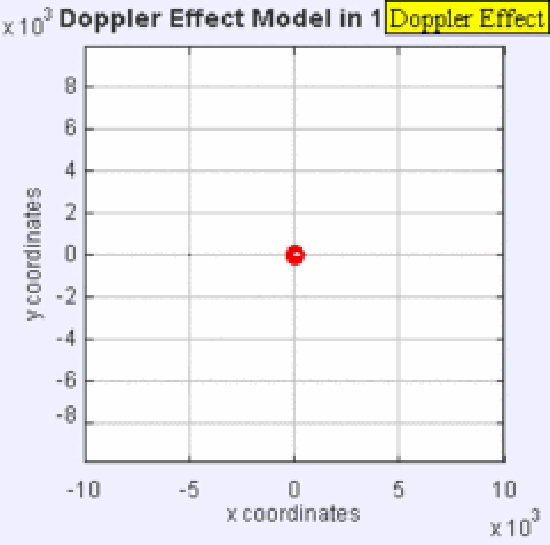
The Doppler Effect: The same sound source is radiating sound waves at a constant frequency in the same medium. However, now the sound source is moving to the right with a speed υs = 0.7 c (Mach 0.7). The wave-fronts are produced with the same frequency as before. However, since the source is moving, the centre of each new wavefront is now slightly displaced to the right. As a result, the wave-fronts begin to bunch up on the right side (in front of) and spread further apart on the left side (behind) of the source.
In classical physics, where the speeds of source and the receiver relative to the medium are lower than the velocity of waves in the medium, the relationship between observed frequency (f) and emitted frequency (fo) is given by: \(\mathrm{f=\frac{(c+vr)}{(c+vs)} \times f_0}\) where c – velocity of the sound waves in the medium, vr– velocity of the observer or reciever, vs – velocity of the sound source, and f0 – original frequency of the sound waves.
The above formula assumes that the source is either directly approaching or receding from the observer. If the source approaches the observer at an angle (but still with a constant velocity), the observed frequency that is first heard is higher than the object’s emitted frequency. Thereafter, there is a monotonic decrease in the observed frequency as it gets closer to the observer, through equality when it is closest to the observer, and a continued monotonic decrease as it recedes from the observer. When the observer is very close to the path of the object, the transition from high to low frequency is very abrupt. When the observer is far from the path of the object, the transition from high to low frequency is gradual.
If the speeds and are small compared to the speed of the wave, the relationship between observed frequency and emitted frequency is approximately
Observed frequency: \(\mathrm{f=(1+\frac{Δv}{c})f_0}\)
Change in frequency: \(\mathrm{Δf=\frac{Δv}{c}f_0}\)
where \(\mathrm{Δv}\) is the velocity of the receiver relative to the source: it is positive when the source and the receiver are moving towards each other.
Sonic Booms
A sonic boom is the sound associated with the shock waves created by an object traveling through the air faster than the speed of sound.
learning objectives
- Identify conditions that lead to a sonic boom and discuss its properties
Sonic Booms
A sonic boom is a sound associated with the shock waves created by an object traveling through the air faster than the speed of sound. It can be viewed as a Doppler effect on steroids; sonic booms generate an enormous amount of energy and sound like explosions. The first man-made object to ever create this phenomenon was a bullwhip. The ‘crack’ of the whip is a result of this sonic boom. This version of a Doppler effect is demonstrated by.
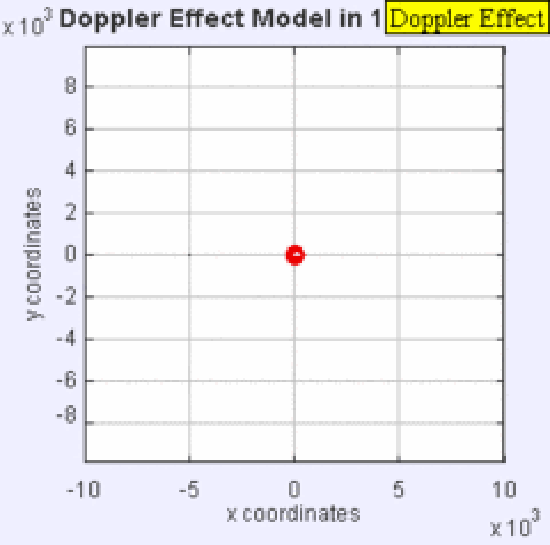
Sonic Boom Gif: The sound source has now broken through the sound speed barrier, and is traveling at 1.4 times the speed of sound, (Mach 1.4). Since the source is moving faster (with a speed ) than the sound waves it creates, it actually leads the advancing wavefront. The sound source will pass by a stationary observer (with a speed ) before the observer actually hears the sound it creates.
When the sound source passes through the air, it creates a series of pressure waves. These waves are travelling at the speed of sound, and as the speed of the sound source increases, the waves, not being able to get out of each other’s way, are forced together. They eventually merge into a single shock wave traveling at the speed of sound. This is a critical speed, known as Mach. The shock waves radiate out from the sound source, and create a “Mach cone’. The half-angle, αα, can be found using the equation
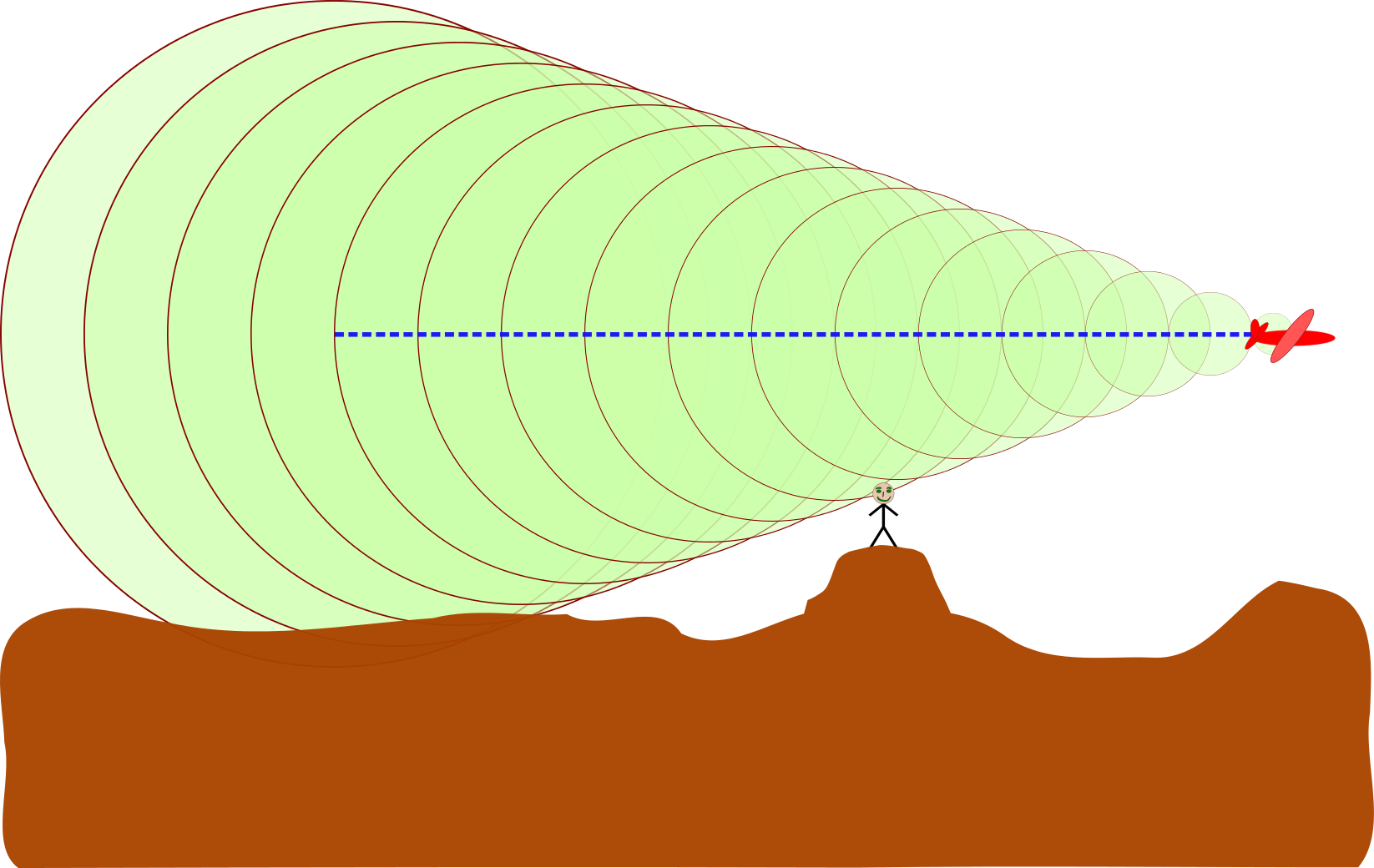
Sonic Boom: A sonic boom produced by an aircraft moving at M=2.92, calculated from the cone angle of 20 degrees. An observer hears the boom when the shock wave, on the edges of the cone, crosses his or her location
\[\mathrm{\sin α= \dfrac{v_s}{v_r}.}\]
From previous atoms, we know that \(\mathrm{\frac{v_s}{v_r}}\) is the sound source’s Mach number.
At the front of the sound source, there is a sudden rise in pressure, while at the end of the source there is a decreasing pressure. This ‘overpressure profile’ is known as an N-wave. There is a big boom when there is a sudden change in pressure, and since the pressure changes twice, this is a double boom.
Key Points
- When the object in motion moves towards the other, the frequency is increased because the time between successive sound waves is shortened. Therefore the pitch is higher.
- When the object in motion moves away from the other, the frequency is decreased because the time between successive sound waves is lengthened. Therefor the pitch is lowered.
- Unless the objects are in each other’s direct path, you need to account for the angle they are at relative to each other. The following equation needs to be substituted for the ‘movers’ velocity. The angle used needs to be the angle from the line of sight of the observer to the sound source. vradial=v∗cosθvradial=v∗cosθ.
- When the object in motion moves towards the other, the frequency is increased because the time between successive sound waves is shortened (therefore the pitch is higher).
- When the object in motion moves away from the other, the frequency is decreased because the time between successive sound waves is lengthened (therefore the pitch is lowered).
- Unless the objects are in each other’s direct path, you need to account for their angle relative to each other. The following equation must be substituted for the ‘movers’ velocity. The angle used must be the angle from the line of sight of the observer to the sound source.
- When the object in motion moves towards the other, the frequency is increased because the time between successive sound waves is shortened. Therefore the pitch is higher.
- When the object in motion moves away from the other, the frequency is decreased because the time between successive sound waves is lengthened. Therefor the pitch is lowered.
- If the speeds and are small compared to the speed of the wave, the relationship between observed frequency and emitted frequency is approximately: \(\mathrm{f=(1+\frac{Δv}{c})f_0}\) where \(\mathrm{Δv} \) is the velocity of the receiver relative to the source: it is positive when the source and the receiver are moving towards each other.
- A sonic boom happens when a sound source passes an observer at a speed either very close to, or faster than the speed of sound.
- Sonic booms generate an enormous amount of energy, and sound like explosions.
- The half angle of the cone of sound waves produced by the sonic boom can be found by taking the inverse sine of the object’s Mach number.
Key Terms
- Doppler's effect: Apparent change in frequency of a wave when the observer and the source of the wave move relative to each other.
- classical physics: All aspects of physics developed before the rise of quantum mechanics.
- frequency: The quotient of the number of times n a periodic phenomenon occurs over the time t in which it occurs: \(\mathrm{f=n/t}\).
- Mach number: The ratio of the velocity of a body to that of sound in the surrounding medium.
- sonic boom: The audible effect of a shock wave in the air, especially one caused by an aircraft flying faster than the speed of sound
LICENSES AND ATTRIBUTIONS
CC LICENSED CONTENT, SHARED PREVIOUSLY
- Curation and Revision. Provided by: Boundless.com. License: CC BY-SA: Attribution-ShareAlike
CC LICENSED CONTENT, SPECIFIC ATTRIBUTION
- Doppler effect. Provided by: Wikipedia. Located at: en.Wikipedia.org/wiki/Doppler_effect%23General. License: CC BY-SA: Attribution-ShareAlike
- Rory Adams, Free High School Science Texts Project, Kosma von Maltitz, and Heather Williams, Doppler Effect. September 18, 2013. Provided by: OpenStax CNX. Located at: http://cnx.org/content/m30847/latest/. License: CC BY: Attribution
- OpenStax College, Doppler Effect and Sonic Booms. September 18, 2013. Provided by: OpenStax CNX. Located at: http://cnx.org/content/m42712/latest/. License: CC BY: Attribution
- Boundless. Provided by: Boundless Learning. Located at: www.boundless.com//physics/definition/doppler-effect--2. License: CC BY-SA: Attribution-ShareAlike
- Dopplereffectsourcemovingrightatmach0.7. Provided by: Wikipedia. Located at: en.Wikipedia.org/wiki/File:Dopplereffectsourcemovingrightatmach0.7.gif. License: CC BY-SA: Attribution-ShareAlike
- Sound and the Doppler Effect. Located at: http://www.youtube.com/watch?v=KJpLDCfyDj4. License: Public Domain: No Known Copyright. License Terms: Standard YouTube license
- OpenStax College, Doppler Effect and Sonic Booms. September 18, 2013. Provided by: OpenStax CNX. Located at: http://cnx.org/content/m42712/latest/. License: CC BY: Attribution
- Doppler effect. Provided by: Wikipedia. Located at: en.Wikipedia.org/wiki/Doppler_effect%23General. License: CC BY-SA: Attribution-ShareAlike
- Rory Adams, Free High School Science Texts Project, Kosma von Maltitz, and Heather Williams, Doppler Effect. September 18, 2013. Provided by: OpenStax CNX. Located at: http://cnx.org/content/m30847/latest/. License: CC BY: Attribution
- Boundless. Provided by: Boundless Learning. Located at: www.boundless.com//physics/definition/the-doppler-effect. License: CC BY-SA: Attribution-ShareAlike
- Dopplereffectsourcemovingrightatmach0.7. Provided by: Wikipedia. Located at: en.Wikipedia.org/wiki/File:Dopplereffectsourcemovingrightatmach0.7.gif. License: CC BY-SA: Attribution-ShareAlike
- Sound and the Doppler Effect. Located at: http://www.youtube.com/watch?v=KJpLDCfyDj4. License: Public Domain: No Known Copyright. License Terms: Standard YouTube license
- Dopplereffectsourcemovingrightatmach0.7. Provided by: Wikipedia. Located at: en.Wikipedia.org/wiki/File:Dopplereffectsourcemovingrightatmach0.7.gif. License: CC BY-SA: Attribution-ShareAlike
- OpenStax College, Doppler Effect and Sonic Booms. September 18, 2013. Provided by: OpenStax CNX. Located at: http://cnx.org/content/m42712/latest/. License: CC BY: Attribution
- Doppler effect. Provided by: Wikipedia. Located at: http://en.Wikipedia.org/wiki/Doppler_effect%23General. License: CC BY-SA: Attribution-ShareAlike
- Rory Adams, Free High School Science Texts Project, Kosma von Maltitz, and Heather Williams, Doppler Effect. September 18, 2013. Provided by: OpenStax CNX. Located at: http://cnx.org/content/m30847/latest/. License: CC BY: Attribution
- Doppler effect. Provided by: Wikipedia. Located at: en.Wikipedia.org/wiki/Doppler_effect. License: CC BY-SA: Attribution-ShareAlike
- Boundless. Provided by: Boundless Learning. Located at: www.boundless.com//physics/definition/doppler-effect--2. License: CC BY-SA: Attribution-ShareAlike
- frequency. Provided by: Wiktionary. Located at: en.wiktionary.org/wiki/frequency. License: CC BY-SA: Attribution-ShareAlike
- classical physics. Provided by: Wiktionary. Located at: en.wiktionary.org/wiki/classical_physics. License: CC BY-SA: Attribution-ShareAlike
- Dopplereffectsourcemovingrightatmach0.7. Provided by: Wikipedia. Located at: en.Wikipedia.org/wiki/File:Dopplereffectsourcemovingrightatmach0.7.gif. License: CC BY-SA: Attribution-ShareAlike
- Sound and the Doppler Effect. Located at: http://www.youtube.com/watch?v=KJpLDCfyDj4. License: Public Domain: No Known Copyright. License Terms: Standard YouTube license
- Dopplereffectsourcemovingrightatmach0.7. Provided by: Wikipedia. Located at: en.Wikipedia.org/wiki/File:Dopplereffectsourcemovingrightatmach0.7.gif. License: CC BY-SA: Attribution-ShareAlike
- Dopplereffectsourcemovingrightatmach0.7. Provided by: Wikipedia. Located at: en.Wikipedia.org/wiki/File:Dopplereffectsourcemovingrightatmach0.7.gif. License: CC BY-SA: Attribution-ShareAlike
- Sonic boom. Provided by: Wikipedia. Located at: en.Wikipedia.org/wiki/Sonic_boom. License: CC BY-SA: Attribution-ShareAlike
- Sonic boom. Provided by: Wikipedia. Located at: en.Wikipedia.org/wiki/Sonic_boom. License: CC BY-SA: Attribution-ShareAlike
- Boundless. Provided by: Boundless Learning. Located at: www.boundless.com//physics/definition/doppler-effect--2. License: CC BY-SA: Attribution-ShareAlike
- Mach number. Provided by: Wiktionary. Located at: en.wiktionary.org/wiki/Mach_number. License: CC BY-SA: Attribution-ShareAlike
- sonic boom. Provided by: Wiktionary. Located at: en.wiktionary.org/wiki/sonic_boom. License: CC BY-SA: Attribution-ShareAlike
- Dopplereffectsourcemovingrightatmach0.7. Provided by: Wikipedia. Located at: en.Wikipedia.org/wiki/File:Dopplereffectsourcemovingrightatmach0.7.gif. License: CC BY-SA: Attribution-ShareAlike
- Sound and the Doppler Effect. Located at: http://www.youtube.com/watch?v=KJpLDCfyDj4. License: Public Domain: No Known Copyright. License Terms: Standard YouTube license
- Dopplereffectsourcemovingrightatmach0.7. Provided by: Wikipedia. Located at: en.Wikipedia.org/wiki/File:Dopplereffectsourcemovingrightatmach0.7.gif. License: CC BY-SA: Attribution-ShareAlike
- Dopplereffectsourcemovingrightatmach0.7. Provided by: Wikipedia. Located at: en.Wikipedia.org/wiki/File:Dopplereffectsourcemovingrightatmach0.7.gif. License: CC BY-SA: Attribution-ShareAlike
- Sonic boom. Provided by: Wikipedia. Located at: en.Wikipedia.org/wiki/Sonic_boom. License: Public Domain: No Known Copyright
- Sonic boom. Provided by: Wikipedia. Located at: en.Wikipedia.org/wiki/File:Sonic_boom.svg. License: Public Domain: No Known Copyright


